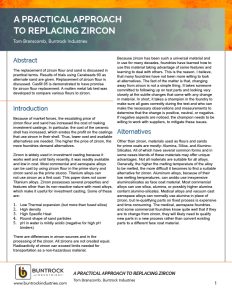A Practical Approach to Replacing Zircon
Abstract
The replacement of zircon flour and sand is discussed in practical terms. Results of trials using Cerabeads 60 as alternate sand are given. Replacement of zircon flour is discussed. Cassill 85 is demonstrated to have promise for zircon flour replacement. A molten metal lab test was developed to compare various flours to zircon.
Introduction
Because of market forces, the escalating price of zircon flour and sand has increased the cost of making investment castings. In particular, the cost of the ceramic shell has increased, which erodes the profit on the castings that use zircon in their shell. Thus, lower cost and available alternatives are needed. The higher the price of zircon, the more foundries demand alternatives.
Zircon is widely used in investment casting because it works well and until fairly recently, it was readily available and low in cost. Most commercial and aerospace alloys can be cast by using zircon flour in the prime slurry and zircon sand as the prime stucco. Titanium alloys cannot use zircon as a first coat. This paper does not cover Titanium alloys. Zircon possesses several properties and features other than its non-reactive nature with most alloys, which make it useful for investment casting. Some of these are:
-
Low Thermal expansion (but more than fused silica)
-
High density
-
High Specific Heat
-
Round shape of sand particles
-
pH in water is mildly acidic (negative for high pH binders)
There are differences in zircon sources and in the processing of the zircon. All zircons are not created equal. Radioactivity of zircon can exceed limits needed for transportation as a non-hazardous material.
Because zircon has been such a universal material and in use for many decades, foundries have learned how to use this material taking advantage of some features and learning to deal with others. This is the reason, I believe, that many foundries have not been more willing to look at alternatives. The fact of the matter is that, changing away from zircon is not a simple thing. It takes someone committed to following up on test parts and looking very closely at the subtle changes that come with any change in material. In short, it takes a champion in the foundry to make sure all goes correctly during the test and who can make the necessary observations and measurements to determine that the change is positive, neutral, or negative. If negative aspects are noticed, the champion needs to be willing to work with suppliers, to mitigate these issues.



